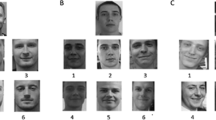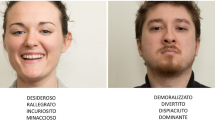Abstract
The Benton Facial Recognition Test (BFRT) and Cambridge Face Memory Test (CFMT) are two of the most common tests used to assess face discrimination and recognition abilities and to identify individuals with prosopagnosia. However, recent studies highlighted that participant–stimulus match ethnicity, as much as gender, has to be taken into account in interpreting results from these tests. Here, in order to obtain more appropriate normative data for an Italian sample, the CFMT and BFRT were administered to a large cohort of young adults. We found that scores from the BFRT are not affected by participants’ gender and are only slightly affected by participant–stimulus ethnicity match, whereas both these factors seem to influence the scores of the CFMT. Moreover, the inclusion of a sample of individuals with suspected face recognition impairment allowed us to show that the use of more appropriate normative data can increase the BFRT efficacy in identifying individuals with face discrimination impairments; by contrast, the efficacy of the CFMT in classifying individuals with a face recognition deficit was confirmed. Finally, our data show that the lack of inversion effect (the difference between the total score of the upright and inverted versions of the CFMT) could be used as further index to assess congenital prosopagnosia. Overall, our results confirm the importance of having norms derived from controls with a similar experience of faces as the “potential” prosopagnosic individuals when assessing face recognition abilities.
Similar content being viewed by others
Notes
Despite that the female sample was much bigger than the male one, Levene’s test for equality of variances did not reveal any significant difference in the variance of the two groups in none of the average scores (all p > .18); for this reason, t and p values for equal variances assumed are reported.
Again, despite that the female sample was much bigger than the male one, Levene’s test for equality of variances did not reveal any significant difference in the variance of the two groups, neither in the total score of the upright and inversion versions of the CFMT, nor in the inversion effect (all p > .11).
References
Schmalzl L et al (2008) Training of familiar face recognition and visual scan paths for faces in a child with congenital prosopagnosia. Cogn Neuropsychol 25(5):704–729
McConachie HR (1976) Developmental prosopagnosia. A single case report. Cortex 12(1):76–82
Bate S et al (2014) Intranasal inhalation of oxytocin improves face processing in developmental prosopagnosia. Cortex 50:55–63
Dalrymple KA, Palermo R (2016) Guidelines for studying developmental prosopagnosia in adults and children. Wiley Interdiscip Rev Cogn Sci 7(1):73–87
Duchaine B, Nakayama K (2006) The Cambridge Face Memory Test: results for neurologically intact individuals and an investigation of its validity using inverted face stimuli and prosopagnosic participants. Neuropsychologia 44(4):576–585
Palermo R et al (2011) Adaptive face space coding in congenital prosopagnosia: typical figural aftereffects but abnormal identity aftereffects. Neuropsychologia 49(14):3801–3812
Benton AL (1994) Contribution to neuropsychological assessment: a clinical manual. Oxford Univeristy Press, USA
Benton AL, Van Allen MW (1968) Impairment in facial recognition in patients with cerebral disease. Trans Am Neurol Assoc 93:38–42
Wilmer JB et al (2012) Capturing specific abilities as a window into human individuality: the example of face recognition. Cogn Neuropsychol 29(5–6):360–392
Susilo T et al (2013) Face perception is category-specific: evidence from normal body perception in acquired prosopagnosia. Cognition 129(1):88–94
Wilmer JB et al (2010) Human face recognition ability is specific and highly heritable. Proc Natl Acad Sci U S A 107(11):5238–5241
Bowles DC et al (2009) Diagnosing prosopagnosia: effects of ageing, sex, and participant-stimulus ethnic match on the Cambridge Face Memory Test and Cambridge Face Perception Test. Cogn Neuropsychol 26(5):423–455
Duchaine B, Germine L, Nakayama K (2007) Family resemblance: ten family members with prosopagnosia and within-class object agnosia. Cogn Neuropsychol 24(4):419–430
Dennett HW et al (2012) The Cambridge Car Memory Test: a task matched in format to the Cambridge Face Memory Test, with norms, reliability, sex differences, dissociations from face memory, and expertise effects. Behav Res Methods 44(2):587–605
Christensen KJ et al (2002) Facial recognition test in the elderly: norms, reliability and premorbid estimation. Clin Neuropsychol 16(1):51–56
Duchaine B, Nakayama K (2004) Developmental prosopagnosia and the Benton Facial Recognition Test. Neurology 62(7):1219–1220
Duchaine B, Weidenfeld A (2003) An evaluation of two commonly used tests of unfamiliar face recognition. Neuropsychologia 41(6):713–720
Busigny T, Rossion B (2010) Acquired prosopagnosia abolishes the face inversion effect. Cortex 46(8):965–981
Delvenne JF et al (2004) Evidence for perceptual deficits in associative visual (prosop)agnosia: a single-case study. Neuropsychologia 42(5):597–612
Herzmann G et al (2008) Toward a comprehensive test battery for face cognition: assessment of the tasks. Behav Res Methods 40(3):840–857
McKone E, Palermo R (2010) A strong role for nature in face recognition. Proc Natl Acad Sci U S A 107(11):4795–4796
Chiroro PM et al (2008) Recognizing faces across continents: the effect of within-race variations on the own-race bias in face recognition. Psychon Bull Rev 15(6):1089–1092
Behrmann M, Avidan G (2005) Congenital prosopagnosia: face-blind from birth. Trends Cogn Sci 9(4):180–187
Cattaneo Z et al (2016) Congenital prosopagnosia is associated with a genetic variation in the oxytocin receptor (OXTR) gene: an exploratory study. Neuroscience 339:162–173
Malaspina M, Albonico A, Daini R (2016) Right perceptual bias and self-face recognition in individuals with congenital prosopagnosia. Laterality 21(2):118–142
Malaspina M et al (2017) What do eye movement tell us about the visual perception of individuals with congenital prosopagnosia? Neuropsychology
Kuder GF, Richardson MW (1937) The theory of the estimation of test reliability. Psychometrika 2(3):151–160
Ferracuti F, Ferracuti S (1992) Taratura del campione italiano. In: test di riconoscimento di volti ignoti. Firenze, p 26–29
Behrmann M et al (2005) Detailed exploration of face-related processing in congenital prosopagnosia: 1. Behavioral findings. J Cogn Neurosci 17(7):1130–1149
Gauthier I, Tarr MJ (1997) Becoming a “Greeble” expert: exploring mechanisms for face recognition. Vis Res 37(12):1673–1682
de Gelder B, Rouw R (2000) Configural face processes in acquired and developmental prosopagnosia: evidence for two separate face systems? Neuroreport 11(14):6
Faglioni P, Cremonini AM, De Renzi E (1991) Taratura su soggetti normali di test di facce sconosciute e familiari: un contributo allo studio della prosopoagnosia, Vita e pensiero
Lewin C, Herlitz A (2002) Sex differences in face recognition—women’s faces make the difference. Brain Cogn 50(1):121–128
McKelvie SJ et al (1993) Gender differences in recognition memory for faces and cars: evidence for the interest hypothesis. Bull Psychon Soc 31(5):447–448
Godard O et al (2013) Sex differences in interhemispheric communication during face identity encoding: evidence from ERPs. Neurosci Res 76(1):58–66
Proverbio AM et al (2006) Gender differences in hemispheric asymmetry for face processing. BMC Neurosci 7(1):44
Herlitz A, Airaksinen E, Nordström E (1999) Sex differences in episodic memory: the impact of verbal and visuospatial ability. Neuropsychology 13(4):590
Sporer S (1999) The own-race bias in Germany: testing the contact hypothesis with Turks and Germans. In: 4th European Conference on Psychology and Law of the American Psychology-Law Association and the European Psychology-Law Association in Dublin, Ireland
Author information
Authors and Affiliations
Corresponding author
Ethics declarations
Conflict of interest
The authors declare that they have no conflict of interest.
Rights and permissions
About this article
Cite this article
Albonico, A., Malaspina, M. & Daini, R. Italian normative data and validation of two neuropsychological tests of face recognition: Benton Facial Recognition Test and Cambridge Face Memory Test. Neurol Sci 38, 1637–1643 (2017). https://doi.org/10.1007/s10072-017-3030-6
Received:
Accepted:
Published:
Issue Date:
DOI: https://doi.org/10.1007/s10072-017-3030-6




